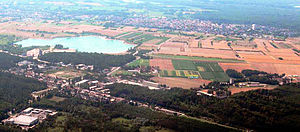Silver lining
| Silver lining (Neuforchheim) | |
|---|---|
| Coordinates | 48 ° 57 '46 " N , 8 ° 20' 12" E |
| height | 116 m |
| surface | 2.1 km² |
| Post Code | 76287 |
| prefix | 0721 |
| Transport links | |
| Stadtbahn ( KVV ) | S 7 S 8 |
| Bus ( KVV ) | 106 |
Silver lining , also called Neuforchheim , is a town in the town of Rheinstetten in the Karlsruhe district of Forchheim . It is located between Bundesstraße 36 and Ettlingen on the Rheinbahn line and has around 650 residents.
The district is located on the western edge of the Hardtwald on the lower terrace of the Upper Rhine (Hochgestade). The Epplesee, which is one of the most popular quarry ponds in the Karlsruhe area, is located near the silver lining . The place is home to a large gravel plant operated by HeidelbergCement AG and the Bruker Biospin company , which has its headquarters there. A branch of the Agricultural Technology Center Augustenberg is also located in the silver lining .
development
The first development in the area of what is now the silver lining was created in 1894 with the construction of the parade ground for the Karlsruhe garrison. At the end of the maneuvers, the imperial parade took place here, and Kaiser Wilhelm II was present several times . Forchheim station was built in 1903 for this reason . In 1917 the parade ground was sold to the Baden Chamber of Agriculture. At the same time, the experimental and teaching material, whose general task was to promote agricultural production, was founded there. The Tobacco Research Institute ( today: Agricultural Technology Center Augustenberg ), with Paul Koenig as its first director, and in 1932 the State Fattening Testing Institute (today: State Institute for Pig Breeding ) were established on this site . The latter moved to Boxberg in Baden in 2006 .
Before the beginning of the Second World War , craft and industrial companies settled at the station - in 1926 the Josef Klein stove factory, in 1936 the Epple gravel works with the start of the dredging of Lake Epple. After the war, an industrial district was built here with a number of important companies, including the Thome furniture factory. When refugees came to Forchheim in 1946 , some of them were housed in the makeshift homes in silver lining that had been there since 1944. In 1950, the Catholic Maria-Hilf-Chapel was built on part of the premises of the Tobacco Research Institute . In 1964, Bruker moved into his newly built, almost 50,000 m 2 company headquarters with laboratories and production facilities.
In order to relieve the area of through traffic of the Karlsruhe Exhibition Center and to meet the requirements of the upgraded and new Karlsruhe – Basel line , the 349 meter long exhibition tunnel was built from 2002 to the end of 2004 , which runs through the silver lining underground. A residential and commercial area was created in 2007 on the site of the former Thome furniture factory, which was demolished in 2005 .
In 2017 it became known that Bruker would relocate its headquarters to Ettlingen by 2021 and completely give up the Silberstreifen location.
traffic
Silberlinien is located directly on the Baden Rheinbahn line and is connected at Forchheim station with the Karlsruhe urban railway lines S7 and S8 every 20/40 minutes with the cities of Karlsruhe and Rastatt and the neighboring towns in between. After Achern and Freudenstadt there are direct connections every hour. Furthermore, Silberstreifen is connected with a bus line between Ettlingen and Neuburgweier every 20/40 minutes.
Epplesee
Between silver stripes and Rheinstetten of Epplesee, one of the most popular is artificial lakes in the region of Karlsruhe. It is used by both bathers and water sports enthusiasts. In the northern part there is a large parking lot, a lawn with a textile area, toilets, a kiosk and a beach volleyball court . On the western bank there is a large nudist area with its own kiosk and toilets.
Gravel is still extracted from the lake today . The name of the lake goes back to the company of the same name, which installed a suction dredger system here and extracts gravel from a depth of 60 meters. Since the water level is far below the surface, high embankments rise up behind the small beach.
The shore at the southern bulge of the lake has been part of the Allmendäcker nature reserve since 1996 and is no longer generally accessible. Swimming and water sports are not allowed in the area.
Web links
- Silver lining in the Stadtwiki Karlsruhe
Individual evidence
- ^ Historical summary of the Forchheim district. City of Rheinstetten, accessed on February 5, 2018 .
- ↑ The history of the LSZ. State Institute for Pig Breeding, accessed on February 5, 2018 .
- ^ Museum of Settlement History in the PAMINA room. museum-digital: Germany, accessed on February 7, 2018 .
- ↑ DB ProjektBau (publisher): Karlsruhe – Basel in focus , No. 1/2010. ( PDF file ( Memento of the original from October 6, 2014 in the Internet Archive ) Info: The archive link has been inserted automatically and has not yet been checked. Please check the original and archive link according to the instructions and then remove this note. , 740 kiB).
- ↑ Plan for the tunneling under Neuforchheim handed over. ka-news.de, accessed on February 5, 2018 .
- ↑ 2001-2010. City of Rheinstetten, accessed on February 5, 2018 .
- ↑ Groundbreaking ceremony. albrings + müller ag, accessed on October 3, 2019 .
- ↑ Bruker Biospin is moving. Rheinpfalz, accessed on October 3, 2019 .
- ↑ Profile of the nature reserve in the LUBW's list of protected areas



